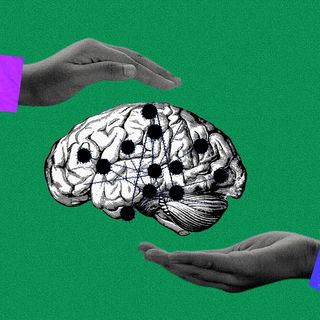
A Study Claimed AirPods Can Work as Inexpensive Hearing Aids
AirPods perform nearly as well as hearing aids in limited conditions — raising questions around barriers to accessing assistive technology.

New research says that wireless earphones perform nearly as well as hearing aids, potentially providing a relatively more affordable alternative to expensive assistive technology for individuals with mild to moderate hearing impairment. Apple’s Live Listen technology that amplifies sound is a feature that works similarly to a personal sound amplification product (PSAP), noted the researchers.
While the recent study rightly highlights the challenges in accessing assistive technology, it also studies the viability of high-end wireless earphones, specifically AirPods, as an alternative to professional hearing aids. This raises an important question: Can commercial products, such as wireless earphones, be an adequate replacement for medically-supervised hearing aid technology or are they limited to being a technocratic solution to a global problem that only a few can access?
Hearing loss is a common disability that affects 20% of the global population. The World Health Organization predicts that by 2050, around 2.5 billion people will have some degree of hearing loss, with at least 700 million people requiring hearing rehabilitation. An editorial published in The Lancet Global Health stated that most people with hearing loss do not seek treatment. The barriers fuelling this neglect include limited awareness, high costs and social stigma. In the United States, it was estimated that 75% of people with hearing loss do not use hearing aids. Uncorrected hearing loss can severely hamper communication, leading to negative impacts on mental health, social isolation and might also increase the risk of dementia.
The high costs of professional hearing aids are a major barrier to accessing assistive technology. Added to this are the costs of follow-up visits to audiologists for frequent tuning of these devices. In their study, the researchers specifically compared Apple’s AirPods 2 and AirPods Pro — “widely available devices” — with both premium and basic hearing aids. The average cost of premium hearing aids is $10,000 while the basic versions cost around $1,500. In comparison, both AirPods models are much more affordable, costing between $129 – 249, the researchers noted.
The team tested the devices on 21 participants with mild to moderate hearing loss, where the participants were asked to repeat a sentence that was read out to them, while wearing each of these devices.
Their findings, published in the journal iScience, found that AirPods Pro performed better, meeting four out of five technology standards for hearing aids. In a quiet environment, AirPods Pro performed similarly to basic hearing aids, but was slightly inferior to the performance of premium hearing aids. AirPods 2 performed the worst, yet researchers noted that it helped participants hear better as compared to wearing no hearing aids at all.
Related on The Swaddle:
1 in 4 People Globally Will Have Some Degree of Hearing Loss by 2050: WHO
In a noisy environment, AirPods Pro performed similarly to premium hearing aids, probably due to its noise-canceling technology, though only when the sounds came from the participant’s lateral direction. When the sounds came from the front, both models failed to help participants hear better.
“Two reasons may account for the difference between the two scenarios… It may relate to the trajectories soundwaves travel with, as well as the advanced signal processing algorithm by premium hearing aids. This finding will hopefully inspire engineers to design hearing aids and personal sound amplification products that are more sensitive in certain directions,” said Ying-Hui Lai, the study’s co-author and a bioengineer at National Yang Ming Chiao Tung University in Taipei.
“Globally, the wireless earphone market is growing rapidly. Some companies are interested in exploring the possibility of designing earbuds with sound amplification features. Our study proves that the idea is plausible,” Lai said. Admittedly, these wireless earphones could serve the purpose of addressing a significant barrier to accessing hearing-aid technology — that of social stigma.
“Many patients are reluctant to wear them because they don’t want to appear old. So, we started exploring if there are more accessible alternatives,” said Yen-fu Cheng, an author of the study. No one may think twice when they see others with earphones plugged in, allowing people to escape unwarranted attention that more conspicuous hearing aids might attract. “These wireless earbuds are of course not perfect, but they would be a good starting point for many patients who don’t have access to professional hearing aids. They will see an increase in quality of life even with these earbuds,” Cheng said.
However, these devices are only meant as an alternative option, and will not address the root cause from which this stigmatization arises. Advocating raising awareness as a first step, The Lancet editorial noted, “Unless we change how societies view people wearing hearing aids and actively engage the community to support people with hearing loss, we can hardly improve the health inequities experienced by this population.”
Moreover, the solution proposed is just a boost, but doesn’t address the experience of hearing loss itself. “This particular study focuses on technical measurements, but the whole hearing aid wearer experience is a bit more complex… For example, the study suggests that AirPods don’t pick up sounds in front of the wearer. In reality, most people need to hear the voices in front of them the most,” Blake Cadwell, founder and CEO of Soundly, a website that helps consumers compare over-the-counter and prescription hearing aids, told The Verge.
These wireless devices fail to improve hearing for those with more advanced hearing loss. An article in The Verge noted that PSAPs might be more affordable than hearing aids, but they amplify all sounds and cannot be customized to suit the individual requirements of people with hearing-impairments. They are also built with the intent of boosting sound for people with normal hearing, for example, birdwatchers.
Related on The Swaddle:
Loud Music, Venues Could Be Putting Over 1 Billion Young People at Risk of Hearing Loss
Access to assistive technology however, is a significant issue that requires global attention. A report released earlier this year by WHO and UNICEF found that while more than 2.5 billion people need one or more assistive products like wheelchairs or hearing aids, access in low and middle income countries can be as low as 3%.
Further, while AirPods might be cheaper when compared with professional hearing aids, they remain a considerably expensive proposition as wireless earphones. The Lancet editorial noted that over 80% of the global population with hearing loss lives in low and middle income countries (LMICs). While AirPods, and other earphones with similar features from competing brands, could potentially help many in developed countries who already own these devices, they may be an unfeasible compensatory strategy for most individuals living in regions where hearing loss is reportedly concentrated.
According to The Lancet editorial, the high costs of hearing aids are due to the global supply being controlled by manufacturers in high-income countries. It suggested bolstering infrastructure support and investments to boost manufacturing of low-cost and safe hearing aids in LMICs while including assistive technologies under national health coverage plans. Over-the-counter hearing aids are gaining popularity, especially in the US after the approval for sale by the Food and Drug Administration (FDA). However, they still do not solve the need for professional assessments to determine what strength and setting an individual needs. “Relying on OTC hearing aids may temporarily alleviate the problem of disease management but it does little in prevention or rehabilitation,” the editorial noted.
As per the recent study, wireless earphones might admittedly improve the quality of life for a certain segment of the global population with significant purchasing power. Yet, at present, they won’t address the needs of a vast majority of people living with hearing impairments. As the editorial stated, “Hearing loss, a pressing yet often invisible problem, requires more attention from global health researchers and a systematic effort that considers various needs of diverse groups with vulnerabilities across the life course.”
Ananya Singh is a Senior Staff Writer at TheSwaddle. She has previously worked as a journalist, researcher and copy editor. Her work explores the intersection of environment, gender and health, with a focus on social and climate justice.
Related


Why Some People Are Convinced They’re Constantly Being Recorded, Watched
